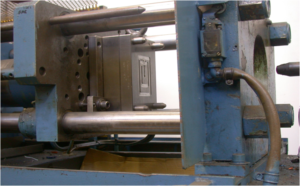History
A natural tropical resin known as Shellac had been in use in the western ethastetarn countries since the middle ages but it was around 18 method was developed for mass production of articles out of it.
- It involved liquefying of the solid resin by application of heat and forcing or “injecting” the melt into a confined cavity having the shape of the intended product. The “cavity” was usually contained in two metal blocks, which could be held together during injection and solidifying of the molten resin and then taken apart to extract the solidified product. The arrangement was called a mould. The existing process of die casting served as a model.
The first injection moulding device for the natural thermoplastics was a modified die casting machine. The range of products was limited to some household utility articles and decorative items. It was the invention of celluloid in 1872 which spurred the development of the injection moulding process.
First patent
The first patent for an injection moulding machine for thermoplastics was registered by the Hyatt brothers in the United States in 1872. It was a vertical, manually operated machine, not much different from that still being used in India for simple, small mouldings in the cottage industry.
A fact, which helped the penetration of the new material in many areas, was the availability of expertise in mould making in the field of glass blowing. Celluloid became a synonym for thermoplastics and many utility articles appeared in the new material in attractive colours and affordable prices. Plastics toys became a rage and ruled the market till the first world war. More than the material, the process of its moulding had brought a revolution in the whole concept of mass production.
The next notable development took place in 1921. Hermann Buchholz of Germany introduced an improved version of the manually operated injection mouldings machine. Eckert and Ziegler, German machine manufacturers, replaced the manual injection with pneumatic force and introduced their invention in 1925 Essentially, it was the vertical machine like its predecessor and the mould closing was still manual.
First manufacturer
Eckert and Ziegler became leading moulding machine manufacturers though many more followed soon. The truly automatic era dawned when the plasticising unit was put in a horizontal position in the thirties and the important parameters like pressure and durations of injection, cooling, etc. could be pre-set.
The plasticising unit consisted of a hollow steel barrel, equipped with band heaters for melting the granules, and a piston or a “plunger” fitting closely in the barrel for injection, powered pneumatically, electrically or hydraulically. Plasticising was improved by introducing a torpedo in the barrel in the path of the melt, so that it received heat not only from outer band heaters but also from inside, though indirectly. Later, the torpedoes too were equipped with internal heaters.
A revolutionary development was the invention of reciprocating single screw plasticising and injection. The screw fulfilled the functions of conveyor, plasticiser, mixer and injection plunger. The first screw pre-plasticising using an injection moulding machine was introduced in 1050 by Ankerwerke of Germany and the principle has given a tremendous boost to plastics.
Thermosets had been processed, since their advent in the first decade of the twentieth century, on vertical presses by semi-automatic processes of compression and transfer moulding. It was in 1963 that a screw pre-plasticising automatic machine was introduced for moulding of thermosetting plastics.
The in-line screw pre-plasticising and injection system has become a norm and has experienced numerous improvements since its introduction. The in-depth studies and research in the behaviour of plastics melts have contributed to the refinement of the functions of the screw pre-plasticising and injection. Computerisation has brought very precise setting, repeatability and control of the parameters.
The closing systems, too, have been refined and extended to electro-hydraulic, servo-hydraulic, fully electric and combinations. Tiebarless and two-plate versions of mould closing systems and the closed-loop injection have extended the scope, productivity and accuracy of the injection moulding process tremendously.
The injection moulding process has not remained confined to thermoplastics, as would be seen in the ensuing chapters.
The injection moulding process
Injection moulding is rightly regarded as the most versatile process for the conversion of thermoplastics. It is perhaps the only process that manufactures even the most intricate articles, right from the raw material to the final form, in one shot, obviating after-operations in most cases.
Basically, the injection moulding process consists of two distinct steps.
- Plasticising or liquefying of the solid plastics
- Transferring the melt to a mould giving it the shape of the intended product and stabilising it in that form.
In practical terms, the process comprises the following operations.
- Plasticising the thermoplastics raw material, i.e. converting it from solid to the fluid through heat energy.
- Injecting the plasticised material in a confined cavity of the shape of the article to be formed.
- Extracting the heat from the injected melt to resolidify the plastics in the given shape.
- Opening the cavity and extracting the solidified moulded article.
The process is carried out by an injection moulding machine, which performs these functions and converts the injected plastics into the intended article with the help of a mould.
Whatsapp for more detail or call 9914109883

